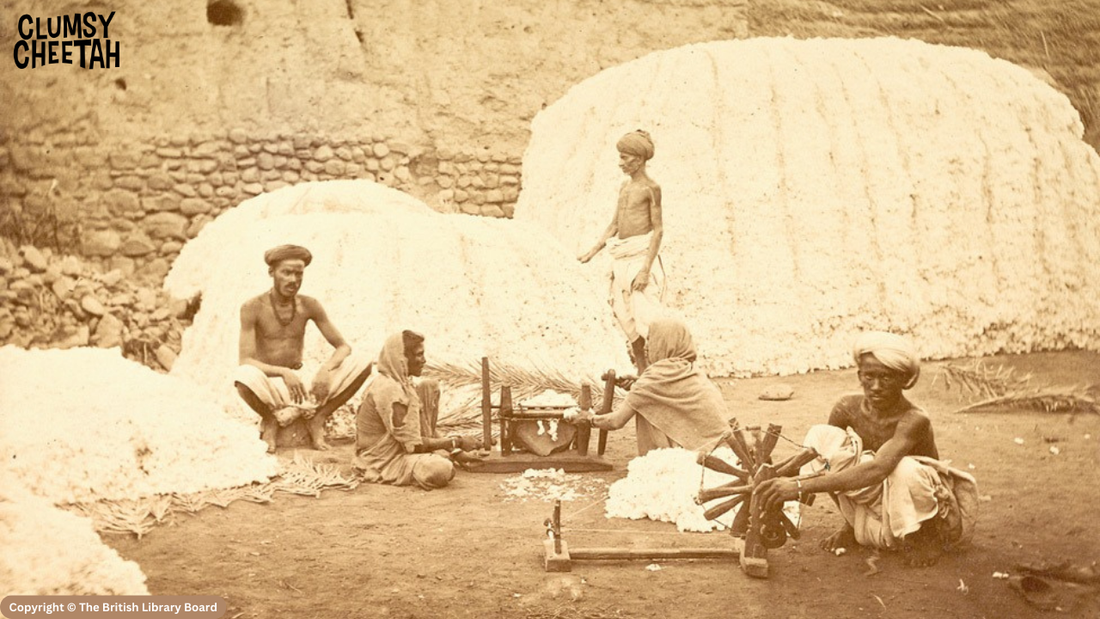
The Journey of Cotton: From Ancient Origins to Modern Comfort
Share
Cotton is a fabric that has stood the test of time, weaving its way into the fabric of human history and becoming an essential part of our daily lives. From ancient civilizations to modern fashion, cotton has played a vital role in clothing humanity. In this blog, we’ll explore the fascinating history of cotton, the invention of cotton yarn, and the many benefits of wearing cotton clothing today.
The History of Cotton: An Ancient Fabric
The history of cotton dates back thousands of years. Evidence of cotton use has been found in the ancient civilizations of both the Indus Valley in modern-day Pakistan and the coastal regions of Peru. Cotton was cultivated and woven into fabric as early as 5,000 B.C., making it one of the oldest known fabrics.
In ancient India, cotton was referred to as "karpasi" and was known for its lightweight and breathable properties, which made it ideal for the hot climate. Similarly, the ancient Egyptians were skilled cotton farmers who grew the plant along the Nile River. Cotton's spread across the world was catalysed by explorers and traders, leading to its growth in popularity in places like Persia, Greece, and eventually Europe.
By the time the 15th century rolled around, cotton had become a global commodity. Its soft texture, versatility, and durability made it highly sought after, and it became a staple in the production of textiles and clothing.
The Invention of Cotton Yarn
Cotton fabric would not be what it is today without the innovation of cotton yarn. Spinning cotton into yarn is a complex process that transforms the raw fibre into thread, which can then be woven into fabric.
In ancient times, cotton yarn was spun by hand using simple tools like the spindle and distaff. However, the process was time-consuming and labor-intensive. The real revolution came in the late 18th century with the invention of the **spinning jenny** by James Hargreaves in 1764. This invention allowed a single worker to spin multiple spools of yarn at once, significantly increasing productivity.
Soon after, Richard Arkwright’s invention of the **water frame** and Samuel Crompton’s **spinning mule** further transformed the cotton industry. These machines automated the spinning process, leading to the mass production of cotton yarn and ultimately reducing the cost of cotton goods. The Industrial Revolution, fueled by such inventions, made cotton fabric accessible to a much larger portion of the population.
The Benefits of Cotton Clothing
Cotton has been a wardrobe staple for centuries, and for good reason! Let’s explore some of the key benefits of cotton clothing:
1. Comfort and Breathability
One of the most significant advantages of cotton is its natural softness. Cotton fibers are incredibly gentle on the skin, making cotton clothing comfortable to wear all day long. The fabric allows air to circulate freely, keeping the body cool and dry even in hot weather. This breathability is what makes cotton the perfect choice for summer wear.
2. Hypoallergenic
Cotton is hypoallergenic, meaning it’s less likely to cause irritation or allergic reactions. This makes it ideal for people with sensitive skin or allergies, and it’s often used in baby clothing, bedding, and medical garments. Cotton’s gentle touch helps prevent rashes and skin irritation.
3. Moisture Absorbent
Cotton can absorb moisture up to 27 times its weight, making it an excellent fabric for wicking away sweat. Whether you’re working out or dealing with humidity, cotton clothing helps keep you dry by drawing moisture away from your skin. This is also why cotton towels are so effective at drying you off after a shower or swim.
4. Sustainability
Cotton is a natural and renewable resource. Unlike synthetic fibers made from petroleum-based products, cotton is biodegradable and environmentally friendly. Sustainable cotton farming practices, such as organic cotton production, help reduce the environmental impact of cotton cultivation by avoiding harmful pesticides and chemicals.
5. Durability
Cotton clothing is known for its durability and strength. High-quality cotton fabrics can withstand repeated washing and wear while maintaining their shape and softness. This longevity makes cotton a practical and cost-effective choice for your wardrobe.
6. Versatility
Cotton’s versatility is unmatched. It can be woven into various types of fabric, from soft, breathable cotton t-shirts to thick, warm cotton jackets. Whether you’re dressing up for a formal event or lounging around at home, cotton fits every occasion.
Cotton in Modern Fashion
In today’s world, cotton continues to dominate the fashion industry. From casual wear like t-shirts and jeans to high-end fashion designs, cotton remains a go-to fabric for designers and consumers alike. Brands like **Clumsy Cheetah** are embracing the timeless appeal of cotton, incorporating it into trendy, sustainable clothing that speaks to modern style while honoring the rich history of this beloved fabric.
As we continue to embrace sustainability and comfort in fashion, cotton’s role will only grow stronger. Its unmatched benefits make it a fabric that has not only stood the test of time but will also continue to define the future of fashion.
Conclusion
From ancient civilizations to cutting-edge fashion, cotton’s journey is one of resilience, innovation, and timeless appeal. The invention of cotton yarn during the Industrial Revolution revolutionized the way we produce fabric, and today, the benefits of wearing cotton continue to make it a wardrobe favourite. Whether you’re looking for comfort, durability, or sustainability, cotton has you covered.
At Clumsy Cheetah we are proud to celebrate the history of cotton by offering high-quality cotton t-shirts that blend classic comfort with modern designs. Discover our latest collection and experience the benefits of cotton for yourself!
